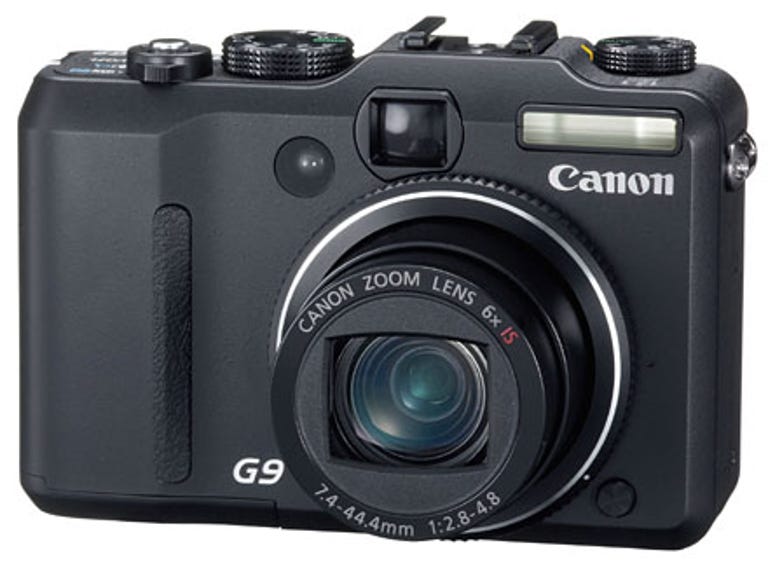 Why You Can Trust CNET
Why You Can Trust CNET Canon PowerShot G9 review: Canon PowerShot G9
The Canon PowerShot G9 is a solid enthusiast camera for those who want something compact to complement a dSLR.
Design
No, you're not having déjà vu -- the Canon PowerShot G9 is physically virtually identical to its predecessor, the G7. The sole differences are an optical viewfinder shrunk to make way for a larger 3-inch LCD and the lens ring and release button darkened from silver to black. Many of the components are identical as well. It incorporates the same f/2.8-4.8 35mm-210mm-equivalent, optically stabilised 6x zoom lens and uses the same Digic III image processor. In fact, the only significant updates are a bump to a 1/1.7-inch 12-megapixel CCD from a 1/1.8-inch, 10-megapixel version, and the much-wished-for return of raw-format support.
The Good
The Bad
The Bottom Line
Weighing about 5.5g more than its predecessor -- likely the result of the larger LCD -- the G9 nevertheless still comes in at 320g. Controls cover the areas of the top and back of the camera not covered by the LCD or the optical viewfinder, leaving just enough space for a decent handhold. It's still true that those with large hands may find it difficult to firmly grip the G9 without accidentally covering one button or another. We also found ourselves wishing that the shutter button and zoom switches were just a bit larger.
Though most of the G9's menu interface and navigation is consistent and easy to follow, there is the occasional bewildering design choice. For instance, the high-resolution (1,024 x 768 at 15fps) movie mode isn't a resolution option under the Func menu, where you'd expect to find it. It's considered a different movie mode, and you must cycle via the scroll wheel through mode selections of Colour Accent, Colour Swap, Time Lapse, Compact, and Standard to find it; sensible from an engineering standpoint, but not so much for users.
Features
And though we all welcome back RAW format support, we were a bit put out by the RAW+JPEG implementation. The camera doesn't store a separate JPEG on the card: it gets extracted from the RAW file during the download process using Canon's image downloader utility. So it's not really RAW+JPEG shooting, and it's close to useless.
Like its predecessor, the G9 offers all of the exposure, focus, and shooting controls any enthusiast would want. They include a spot meter, user-selectable focus zones, two custom settings modes, continuous- or shot-only IS settings, manual ISO settings up to 1,600 plus a High mode that reaches up to 3,200, voice annotation, and a hot shoe.
Performance
Performance remains essentially unchanged from the G7. Time to first shot is a quick 1.7 seconds, though not quite as fast as the G7's 1.5-second start. In bright light, a relatively quick focus helps keep the shutter lag to a manageable 0.5 second. In dim light, that increases to a second. Two shots in a row have a decent 2-second gap between, and adding flash recycle bumps that to only 2.3 seconds. Continuous shooting is down from 36 in the G7 to somewhere between 17 and 19 frames, but it's faster -- 2.3 frames per second (fps) at a low resolution, but more typically 1.7 fps.
The 3-inch LCD is reasonably easy to see in bright sunlight and has a wide viewing angle, but on playback, images tend to look a bit softer with more blown-out highlights than they actually do -- you may want to hold off deleting images until you view them on a full-size display. Though the viewfinder remains larger and more usable than most, we think we were happier with the smaller LCD and bigger optical viewfinder on the G7. Despite its decent movie-capture quality, without the ability to zoom the lens during video, we found the feature less useful on the G9 than on other cameras.
As it uses the same lens as the G7, its similar distortion issues come as no surprise. But Canon probably tweaked the image-processing a bit, because photos this go-round had fewer artifacts. Among the G9's good qualities you'll find an excellent noise profile -- photos hold detail well as high as ISO 400 -- and as usual Canon's exposure and white balance hold up quite well; it renders realistically saturated colours without going overboard. Despite the distortion, the lens holds sharpness from edge to edge; there's little purple fringing, though some magenta and cyan aberration does occur.
The Canon PowerShot G9 gets a leg up over its predecessor by improving photo quality and restoring RAW format support while maintaining the same excellent performance and body design. You probably can't miss with this model as a compact backup for your dSLR.
(Shorter bars indicate better performance)
| Typical shot-to-shot time | Time to first shot | Shutter lag (dim) | Shutter lag (typical) |
(Longer bars indicate better performance)


